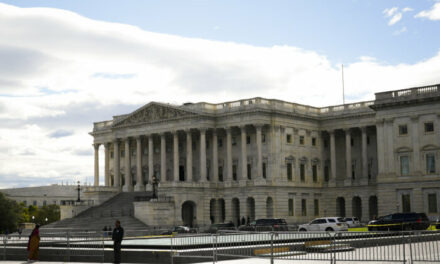We support our Publishers and Content Creators. You can view this story on their website by CLICKING HERE.
It’s unlikely, but not impossible, that neither candidate will receive the 270 electoral votes needed to become president. Here’s what would happen then.
Though it’s a highly unlikely outcome, there is a possibility that former President Donald Trump and Vice President Kamala Harris could end up tied in the Electoral College.
Under the terms laid out in Article II, Section 1 of the U.S. Constitution, to win the presidency, a candidate must receive more than half of all electoral votes. Currently, there are 538 total electoral votes, placing the majority threshold at 270 votes, which constitutes half of the total plus one.
But this year, various election map configurations could result in both Trump and Harris failing to reach this margin and ending up in a 269–269 tie.
The situation wouldn’t be unprecedented in U.S. history: The elections of 1800 and 1824 each ended with no clear electoral victory.
But while the Constitution provides a remedy for the situation, such an outcome could still present a constitutional crisis in the deeply divided modern political landscape.
Here’s how a tie could happen—and what would happen if it did.
How Could It Happen?
In the past two instances where neither candidate received a majority, the outcome was heavily influenced by the presence of third parties and simple procedural errors.
However, with independent Robert F. Kennedy Jr.’s departure from the race, the 2024 contest is now squarely between Trump and Harris, with third-party candidates polling around 1 percent.
Had Kennedy remained in the race, he hypothetically could have prevented either party from winning by taking a single state if the election were close.
But with his decision to drop his bid and back Trump, there’s now practically no chance of a third-party candidate winning a single electoral vote.
Instead, the most likely way this could happen would be for the candidates to receive a tied vote of 269–269. This would constitute exactly 50 percent of the electoral college for each candidate, depriving both of the 270 votes needed to win.
In the current election, countless configurations of states and districts could lead to a tied outcome.
Most pollsters label these states and districts as being in play in November: the Rust Belt trio of Wisconsin, Michigan, and Pennsylvania; the Sun Belt states North Carolina, Georgia, Arizona, and Nevada; and Nebraska’s 2nd congressional district, which awards a single electoral vote.
Such a scenario would generally require unusual regional configurations, such as the Rust Belt trio dividing its votes—which has happened only three times in the past 50 years.
Another path that was possible, though unlikely, involved an effort in Nebraska to convert the state to a winner-take-all electoral model, which would have practically guaranteed Trump an additional electoral vote from the state’s blue-leaning 2nd congressional district.
How Would a Tie Be Resolved?
In the event of a 269–269 tie, neither candidate would meet the constitutional threshold for victory.
The Constitution outlines the process for such an eventuality, called a “contingent election,” very clearly.
Specifically, if neither candidate receives a majority of electoral votes, the matter goes to the incoming House of Representatives, which first meets on Jan. 3, to determine the winner.
The vote would be held after the certification of electoral votes by joint session, which happens on Jan. 6, confirms that neither candidate received a majority.
Lawmakers would not cast individual ballots but would instead vote as state blocs. Thus, New York would have a single vote, Wyoming would have a single vote, and so on.
Each state delegation would take an internal vote, and the candidate who receives the majority would receive the vote of that delegation. Lawmakers would be extremely likely to vote party line in such an election, with some possible exceptions.
To win the presidency in a contingent election, the candidate must receive a majority of voting state delegations.
GOP Advantage
A report on the matter by The Center for Politics found that Republicans would likely have a stronger baseline in such an election than Democrats: Currently, that report says, Republicans have relatively safe majorities in 23 states, while Democrats have a baseline of just 13 state delegations.
The report rates an additional three state delegations as “likely Republican” or “lean Republican.” Democrats, meanwhile, have an additional five states rated as “likely” or “lean” in their favor.
Five states—Michigan, Pennsylvania, Arizona, Maine, and Alaska—are rated toss-ups.
However, The Center for Politics suggests that Rep. Mary Peltola (D-Alaska) would likely face significant pressure to cast her single at-large ballot for Trump, in line with the state’s likely presidential choice.
In Minnesota and North Carolina, House state delegations are currently evenly split between Republicans and Democrats. It’s unclear how delegations would deal with the situation if they were evenly divided.
Still, the report indicates that Republicans are very well-situated to emerge victorious from a contingent election were it to be held. The unusual configuration of contingent elections could ensure Republicans hold a majority of state delegations even if they lose control of the House.
Past Contingent Elections
Such an election has only been carried out in the United States twice.
The first instance was in 1800, when vice presidential candidate Aaron Burr accidentally received the same number of electoral votes as presidential candidate Thomas Jefferson.
At the time, electoral votes for the two positions were not distinguished from each other: the highest vote-getter became president, and the runner-up became vice president. Poor planning on the part of Jefferson’s supporters.
The House ultimately had to take 36 ballots before delivering the presidency to Jefferson, a deadlock broken by the intervention of Jefferson’s longtime rival, former Treasury Secretary Alexander Hamilton.
The second came in 1824.
In that four-way presidential race, Andrew Jackson received the largest share of the popular vote and the electoral vote, while John Quincy Adams was the runner-up, and William Crawford came in third place. However, because Jackson failed to win a majority of electoral votes, the race had to be decided by the House.
The powerful House speaker at the time, Henry Clay—himself a contender who came in fourth place—threw his support behind John Quincy Adams, the electoral and popular vote runner-up. Clay later became Adams’s secretary of state.
The controversial move was labeled by Jackson as a “corrupt bargain” and ignited fierce debate in American politics until Jackson was ultimately elected president in 1828.

 Conservative
Conservative  Search
Search Trending
Trending Current News
Current News 







